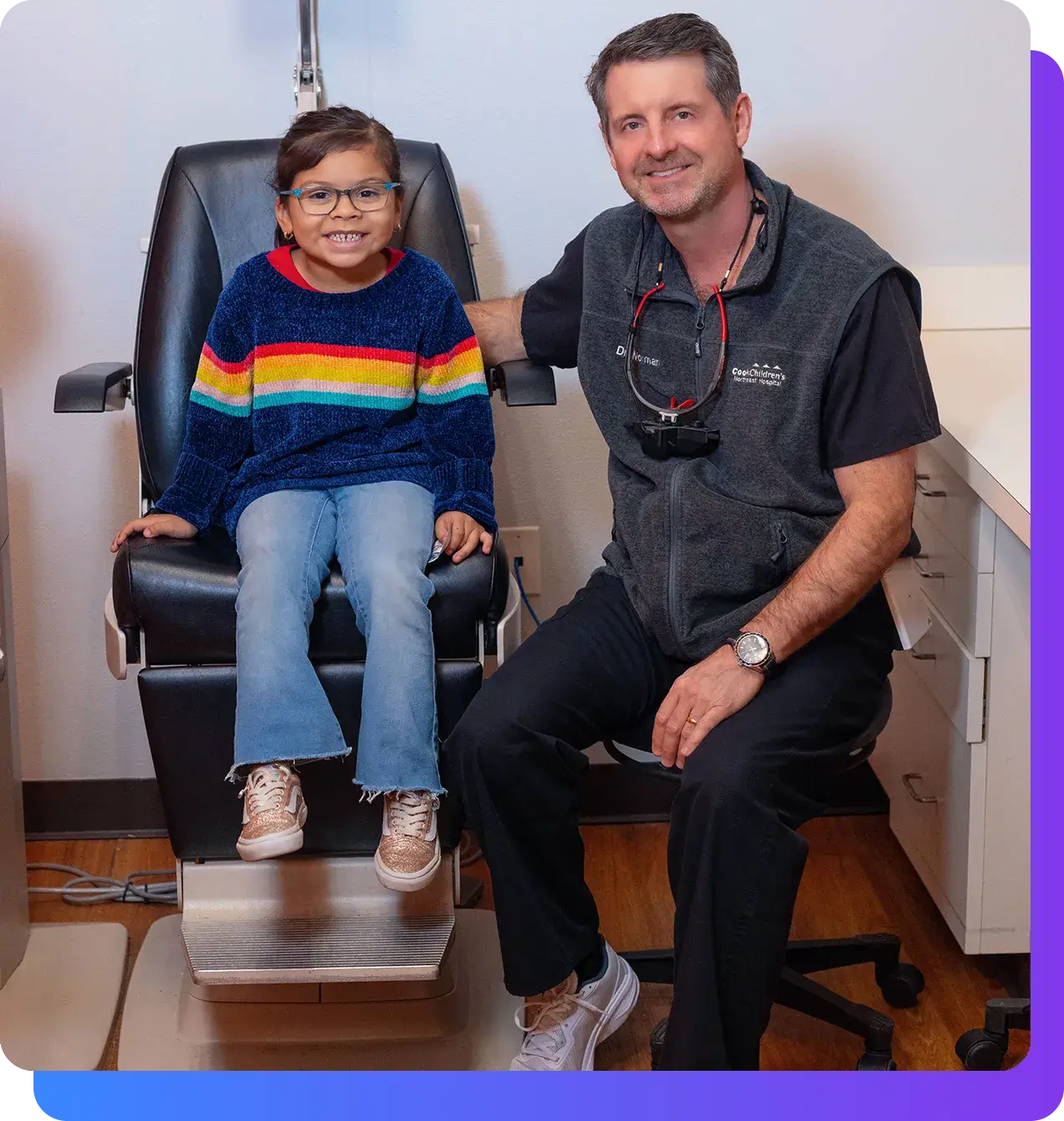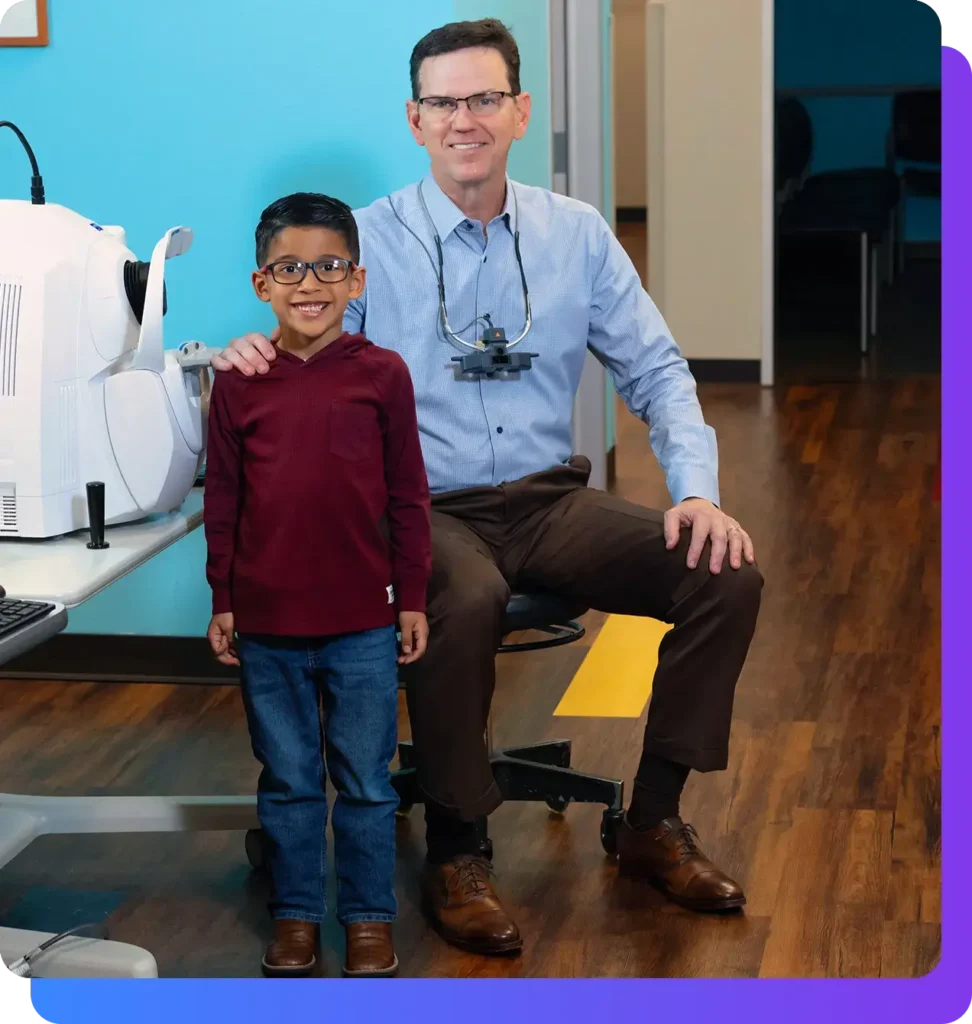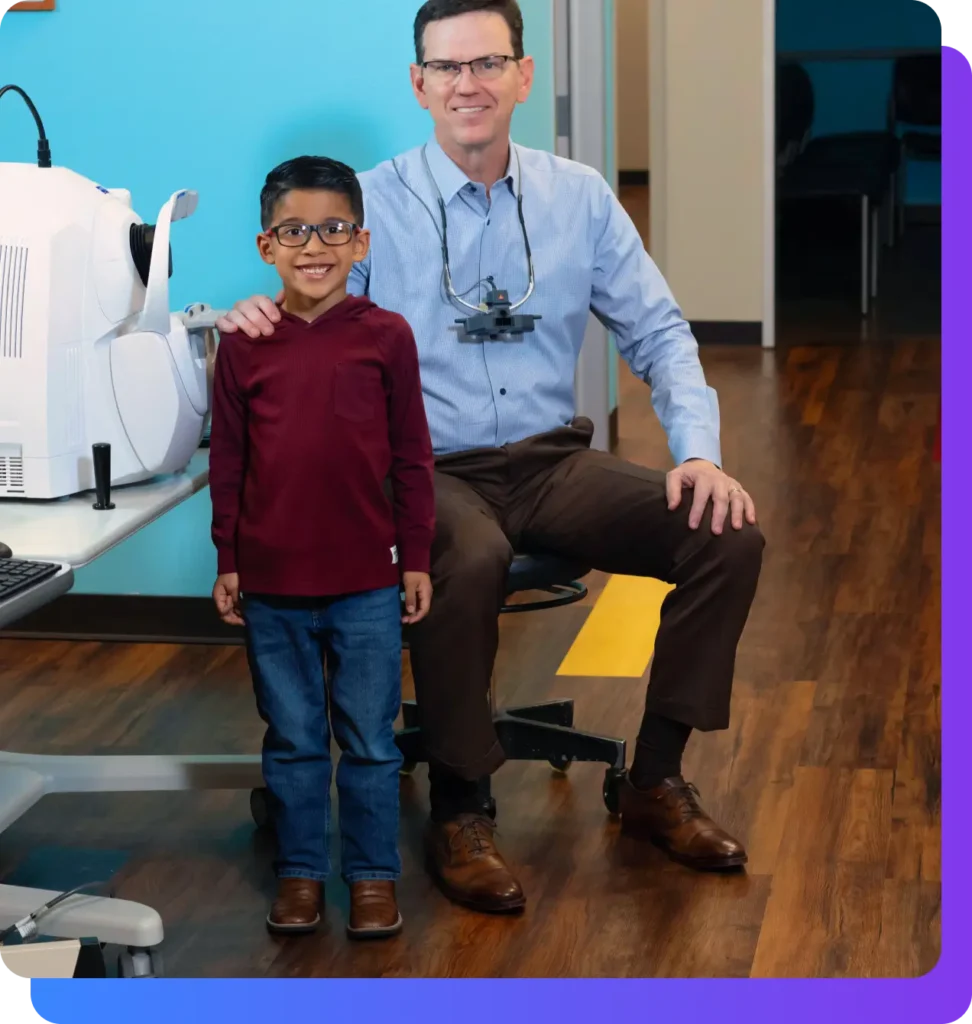Pediatric Double Vision (Diplopia)
Specialists in North Texas
Discovering that your child may be seeing double can be a startling and worrying experience. As a parent, it’s natural to feel a rush of concern, have questions about what could be causing the issue, and experience an urgent need to protect and restore your child’s clear vision.
Expert Double Vision Treatment in North Texas
At Pediatric Eye Specialists, we understand the anxiety and confusion that can come with the suspicion of pediatric diplopia. We’re here to offer not only advanced medical solutions but also a guiding hand of support through this unexpected journey.
We want to assure you that with our specialized pediatric care, expertise in ophthalmology, and commitment to each patient’s health and well-being, your child’s vision can be effectively assessed and treated. Your child’s ability to see the world with clarity is our top priority, and we strive to provide an environment where you can feel confident and reassured about the path ahead. Let’s explore together the steps toward understanding and treating pediatric double vision, ensuring your child can enjoy a bright and vivid future.

The Basics: What is Double Vision (Diplopia)?
Double vision, medically known as diplopia, is the simultaneous perception of two images of a single object that may be displaced horizontally, vertically, or diagonally in relation to each other. In children, this condition can be particularly concerning as it may interfere with their development, learning, and daily activities.
Why Pediatric Eye Specialists for Your Child's Double Vision?
The Most Experienced Team in North Texas
With over sixty-five years of collective pediatric ophthalmology expertise, we offer your child unparalleled collaborative care.
Five Convenient Locations
Easily accessible care with offices in Fort Worth, Denton, Keller, Mansfield, and Prosper,
Unrushed, Clear Communication
We take the time to discuss your child's diagnosis and treatment, ensuring all your questions are answered to ease your concerns.
Affiliated with Cook Children’s Hospital
Our partnership with Cook Children’s Hospital means if your child needs surgery, imaging, or other specialists, they will be treated in one of the nation’s leading pediatric hospitals.
Specialized Expertise
Our expertise means that more optometrists, doctors, and specialists refer their pediatric eye patients to Pediatric Eye Specialists than any other pediatric eye practice in North Texas.
Child and Family Focused
Kids love us, and we love kids! We provide a caring environment for your child and your family.
Advanced Diagnostic Technology
We have the most comprehensive pediatric diagnostic suite in North Texas, allowing for precise diagnosis and highly personalized treatment plans.
Every Child Needs Access to Expert Eye Care
Championing the right to sight, we help navigate insurance, cash pay, and Medicaid options to make superior eye care feasible for all children regardless of their socioeconomic status.

The Benefits of Treatment for Double Vision in Children
By treating double vision, your child can experience clearer, single vision, improved academic performance, enhanced participation in activities, and increased self-confidence.
Success Your Child Can Expect
Restore Single Vision
Correcting double vision through proper medical treatment allows children to again see one clear image, reducing disruptive strain.
Read Comfortably
With treatment eliminating doubling effects, kids can enjoy reading without headaches or dizziness from trying to merge split visual input.
Realign Eyes
Successful diplopia therapy brings eyes back into coordination for accurate depth perception and hand-eye coordinatiion.
Expand Mobility
Treating double vision restores balance and clarity of sight, enabling safer movement and reducing risky falls.
Increase Sports Participation and Activities
Aligning eyes via effective therapy assists children in comfortably tracking moving objects, expanding possible sports and activities opportunities.
Build Confidence
Restoring orderly vision through treatment provides an appearance and capability boost to self-assurance.
Get Ahead of Future Issues
Catching double vision early to realign visual axes helps prevent long-term threats like amblyopia (sometimes called lazy eye).
Real Stories,
Real Smiles.
“They were very good with my nonverbal toddler. It was the best doctor visit experience we have had yet. They were awesome, caring, and quick!.”

Amy Glover
Parent of Patient
“Today, Dr. Packwood saved my youngest from a life of blindness and worked a miracle for my family. I cannot express enough gratitude and thanks for their skillful surgery and expertise. 10 of 10 highly recommend.”

Atticus Lee
Parent of Patient
“The staff here is so amazing with my son. We had such a wonderful experience both at the office and for his surgery! I highly recommend Pediatric Eye Specialists!!!!“

Gianna Stutzman
Parent of Patient
“We are so grateful for the genuine care that Dr. Duff provided for our son Lorenzo, which prevented him from going blind! She is truly a gift to the community.“

JS Cocjin
Parent of Patient
“Professional, compassionate, kind and friendly. They took great care of my preemie baby from Day 1 of ROP. Very happy with how my daughter is progressing and has healthy eyes now.”

Suresh K.C.
Parent of Patient
“We’ve seen Dr. Hunt for the past 6 years since my daughter was 9 days old. We have multiple appointments each year and even eye surgery when she was 1. Our experience here has been fantastic every time and we highly recommend this group!.”

Mandy Edmondson
Parent of Patient
“Dr. Norman has always been very attentive and thorough with my daughter, who has Type 1 Diabetes. The staff are warm and always do their best to be accommodating. I highly recommend Dr. Norman.”

Tricia Moon
Parent of Patient
“Absolutely recommend! All around great experience! They made my son feel comfortable during the visit. Treatment was explained, and I walked out with no questions. I loved it. “

Cynthia Valero
Parent of Patient
“Great staff, great doctors; they know how to help ease kids’ fears and provide excellent service. Had to get my little one in same day for an eye injury, and they found a way to make it happen. Would 100% recommend.“

Kris K
Parent of Patient
Start your child’s journey to better vision today.
Embrace a future of clearer vision and confidence for your child. Contact us now to book your consultation at any of our convenient locations across the Metroplex.
Click to Explore Double Vision
Causes of Pediatric Double Vision (Diplopia)
Pediatric double vision, or diplopia, can stem from various sources. Identifying the root cause is crucial for effective treatment. Here are some potential causes:
Genetic Factors
Some children inherit conditions that predispose them to double vision. These can include anatomical variations that affect eye alignment or muscle control.
Underlying Health Conditions
Certain systemic diseases, like diabetes or thyroid disorders, can impact eye muscles or nerves, leading to double vision. Neurological conditions such as cerebral palsy or multiple sclerosis are also known to cause visual disturbances.
Ocular Muscle Imbalances
The muscles that control eye movement may be imbalanced or weak, causing the eyes to misalign. This misalignment can result in double vision when both eyes are open.
Refractive Errors
Significant differences in vision prescription between the two eyes (anisometropia) can cause double vision as each eye sends a different image to the brain.
Trauma or Injury
Head injuries that affect the brain or nerves related to eye movement can result in temporary or permanent double vision.
Infections or Inflammation
Conditions such as uveitis or meningitis that cause inflammation in or around the eyes can disrupt normal vision and lead to diplopia.
Neurological Disorders
Problems with the nerves that control eye muscles, such as a cranial nerve palsy, can lead to double vision.
Understanding these causes allows Pediatric Eye Specialists to tailor a diagnostic and treatment approach that best suits the child’s needs, ensuring a clearer path to improved vision.
Understanding these causes is vital for Pediatric Eye Specialists in diagnosing and formulating an effective treatment plan for double vision.
Signs and Symptoms of Pediatric Double Vision
Early detection of double vision, or diplopia, in children is key to timely and effective treatment. Parents and caregivers should be aware of these signs and symptoms:
Seeing Double Images
The most direct symptom of diplopia is perceiving two images of a single object. Children might complain about seeing everything double or might be observed squinting or closing one eye to see clearly.
Frequent Eye Squinting or Closing One Eye
To cope with the confusion of double images, children often squint or close one eye. This behavior is particularly noticeable during activities requiring sharp focus, like reading or watching TV.
Eye Strain and Headaches
Struggling to focus with misaligned eyes can lead to eye strain, resulting in headaches or complaints of eye pain, especially after visual tasks.
Difficulty in Hand-Eye Coordination
Children with diplopia may have trouble with tasks that require precise hand-eye coordination, such as catching a ball or coloring within lines.
Unusual Head Tilts or Postures
To compensate for the double vision, children might adopt an unusual head position, such as tilting or turning their head to one side, which can help merge the two images into one.
Avoidance of Visual Tasks
Children may avoid activities that exacerbate their double vision, such as reading or playing certain games.
Nausea or Dizziness
In some cases, the disorientation caused by double vision can lead to feelings of nausea or dizziness.
Recognizing these signs early and consulting with Pediatric Eye Specialists can lead to a proper diagnosis and effective treatment plan, significantly improving the child’s quality of life and visual health.
Have Concerns?
If you suspect your child is experiencing double vision, early intervention is crucial. At Pediatric Eye Specialists, we are committed to providing comprehensive care and support to ensure the best possible outcomes for your child’s vision health. Our team of experts is dedicated to diagnosing and treating pediatric diplopia with the latest medical techniques and compassionate care.
Diagnosing Pediatric Double Vision
Diagnosing double vision, or diplopia, in children is a meticulous process that involves several steps and diagnostic tests:
Initial Examination
A thorough eye examination is the first step. Pediatric ophthalmologists at Pediatric Eye Specialists conduct a detailed evaluation, focusing on the child’s vision, eye movements, and the alignment of the eyes. This examination often includes assessing visual acuity to determine if glasses might be needed.
Patient History
Understanding the child’s medical history is crucial. The doctors inquire about any previous eye issues, injuries, or systemic disorders like diabetes or thyroid diseases that could contribute to double vision.
Refraction Test
A refraction test determines if refractive errors like astigmatism contribute to the child’s vision problems. This test helps in prescribing the right lenses to correct vision.
Eye Muscle Function Tests
These tests assess the strength and functionality of the extraocular muscles. They help identify any muscle weakness or imbalances contributing to double vision.
Neurological Evaluation
Since the brain plays a critical role in processing visual information, neurology is a key aspect of diagnosis. Neurological evaluations check for any underlying brain conditions or nerve disorders that might cause diplopia.
Imaging Tests
Advanced imaging tests, such as CT scans or MRI, might be recommended to examine the brain, optic nerves, and eye structures in detail, especially if a neurological cause is suspected.
Specialized Tests
In some cases, further specialized tests are conducted, such as tests for dry eye syndrome or an eye patch test to differentiate between monocular and binocular diplopia.
Collaboration with Other Specialists
If needed, Pediatric Eye Specialists may collaborate with other healthcare professionals, such as neurologists or endocrinologists, especially if the double vision is related to systemic health issues.
By combining these diagnostic approaches, Pediatric Eye Specialists ensures a comprehensive evaluation, leading to an accurate diagnosis and effective treatment plan for pediatric double vision. This multidisciplinary approach is essential in addressing the complex nature of diplopia in children.
Treatments for Pediatric Double Vision
Pediatric double vision, or diplopia, can be addressed through various treatment modalities. These are broadly classified into nonsurgical and surgical options, based on the severity and underlying cause of the condition.
Nonsurgical Treatments
Glasses with Corrective Lenses
For children whose double vision is caused by refractive errors such as astigmatism, glasses with the correct prescription can often resolve the issue.
Prism Lenses
Prism lenses are a common nonsurgical treatment for double vision. They alter the light path to the eyes, helping align the images seen by each eye, thereby reducing or eliminating diplopia.
Patching or Eye Occlusion Therapy
This treatment involves covering the stronger eye to stimulate and strengthen the weaker eye, often used in cases where amblyopia is present alongside diplopia.
Medications
In cases where double vision is caused by a nerve or muscle disorder, medications may be prescribed to manage the underlying condition. This could include drugs for diabetes, thyroid disease, or myasthenia gravis.
Lifestyle Adjustments
In some cases, simple lifestyle adjustments like altering the child’s reading position or using specialized lighting can help manage symptoms of double vision.
Surgical Treatments
Strabismus Surgery
Strabismus surgery is performed to correct the misalignment of the eyes. It involves adjusting the length or position of the eye muscles to align the eyes correctly.
Cataract Surgery
If diplopia is caused by cataracts, removing the clouded lens and replacing it with an artificial lens can resolve the double vision.
Neurosurgery
In rare cases where double vision is due to a brain or neurological condition, such as a brain tumor or aneurysm, neurosurgical intervention might be necessary.
Pediatric Eye Specialists carefully evaluates each case of pediatric double vision to determine the most appropriate treatment plan. The choice of treatment depends on various factors, including the child’s age, the severity of the condition, and the underlying cause. The goal is always to restore clear, comfortable binocular vision, thereby enhancing the child’s quality of life.
Our commitment at Pediatric Eye Specialists is to provide your child with the highest standard of care, combining medical expertise with compassion and understanding.
Typical Expected Outcomes for Pediatric Double Vision Treatments
When addressing pediatric double vision, or diplopia, it’s crucial for parents to have a realistic understanding of treatment outcomes. While each case is unique, here are some general expectations:
Improvement in Visual Alignment
The primary goal of most treatments, both surgical and nonsurgical, is to improve the alignment of the eyes. This often leads to a significant reduction or elimination of double vision.
Enhanced Visual Comfort
As the alignment of the eyes improves, children typically experience increased visual comfort. This includes a reduction in symptoms like eye strain and headaches.
Varied Response to Treatment
Response to treatment can vary based on the underlying cause of double vision and the child’s overall health. Some children may experience immediate improvement, while others might require longer treatment periods or multiple interventions.
Monitoring and Follow-Up
Continuous monitoring is essential, especially in growing children, as changes in the visual system can occur. Regular follow-ups help in adjusting treatment plans as needed.
Management of Underlying Conditions
In cases where diplopia is caused by systemic health issues, managing these underlying conditions is crucial for the overall treatment success.
Potential Need for Ongoing Therapy
Some children may benefit from ongoing vision therapy or corrective lenses to maintain optimal vision and manage any residual symptoms of double vision.
Surgical Success Rates
When surgery is indicated, it generally has a high success rate in properly aligning the eyes and reducing double vision. However, in some cases, additional surgeries may be necessary.
Long-Term Prognosis
With early and appropriate treatment, the long-term prognosis for children with double vision is generally positive. Most children adapt well and can enjoy normal visual activities.
Pediatric Eye Specialists aims to provide the best possible outcomes, taking into account each child’s specific needs and circumstances. Parents should maintain open communication with their child’s eye care team to understand the specific prognosis and recovery process for their child.
Secure a Brighter Future: Schedule Your Child's Diplopia Consultation Today
Is your child experiencing the challenges of double vision? At Pediatric Eye Specialists, we understand the complexity and concerns surrounding your child’s visual health. Our dedicated team of experts is equipped to provide comprehensive care and the most effective treatment options for pediatric double vision. Don’t wait for the symptoms to escalate—early intervention is key to successful outcomes. Take the first step towards clear, comfortable vision for your child. Schedule an appointment with us today and ensure your child’s path to optimal visual health is clear and bright.

Start your child’s journey to better vision today.
Embrace a future of clearer vision and confidence for your child. Contact us now to book your consultation at any of our convenient locations across the Metroplex.
How quickly should I seek medical advice if I suspect my child has double vision?
It’s important to consult with a pediatric ophthalmologist as soon as you notice any signs of double vision in your child. Early evaluation and diagnosis are crucial for effective treatment and preventing potential complications.
Can double vision affect my child’s learning and school performance?
Yes, double vision can impact a child’s ability to read, write, and participate in classroom activities, which can affect their overall academic performance. Timely treatment can help mitigate these issues.
Is double vision in children always a sign of a serious underlying condition?
While double vision can sometimes indicate a serious condition, it often results from less severe issues like uncorrected refractive errors or eye muscle imbalances. A thorough evaluation is essential to determine the cause.
Are there any specific tests for diagnosing double vision in children?
Yes, diagnosing double vision typically involves a comprehensive eye examination, refraction tests, eye muscle function tests, and possibly neurological evaluations or imaging tests like CT scans or MRIs.
Will my child need to wear glasses to correct double vision?
Glasses may be prescribed if the double vision is due to refractive errors or specific eye conditions. In some cases, prism lenses might be recommended to help align the images.
Can lifestyle changes help manage my child’s double vision?
Certain lifestyle adjustments, such as using proper lighting while reading or taking frequent breaks during visually intensive tasks, can help manage the symptoms of double vision.
What should I do if my child complains of headaches along with double vision?
If your child is experiencing headaches along with double vision, it’s important to schedule an appointment with Pediatric Eye Specialists. Headaches can be a symptom of eye strain due to diplopia.
Is surgery a common treatment for pediatric double vision?
Surgery may be considered for double vision caused by eye muscle imbalances or other structural issues. The need for surgery depends on the specific cause and severity of the double vision.
What is monocular diplopia, and how does it affect a child’s vision?
Monocular diplopia occurs when double vision is present in one eye even when the other eye is closed. This can be due to conditions affecting the lens, cornea, or retina, such as astigmatism, cataracts, or swelling and scarring. It can impact a child’s visual perception, making problem-solving and learning more challenging.
Can pediatric diplopia be a result of a traumatic brain injury?
Yes, double vision can sometimes arise following a traumatic brain injury due to damage to the brain’s areas that control vision or the nerves that coordinate eye movement.
Is it common for children with blurred vision to also experience double vision?
Blurred vision and double vision can occur together if a child’s eye condition affects both the clarity of the image and the alignment of images from each eye, necessitating a comprehensive eye examination by a professional in optometry.
How can an eyepatch help in treating pediatric double vision?
An eyepatch might be used in the treatment of pediatric diplopia to strengthen a weaker eye. By covering the stronger eye, the weaker one is forced to work harder, which can help improve overall visual function. If the double vision is due to eye misalignment, wearing of the patch will relieve the double vision while the patch is on.
What’s the connection between a brain tumor and pediatric double vision?
A brain tumor can press against the nerves controlling eye muscles or parts of the brain that process visual information, leading to visual impairment, including double vision.
How are orthoptics used in the treatment of pediatric double vision?
Orthoptics is a field of ophthalmology focusing on improving the coordination of the extraocular muscles, which can help correct issues like convergence insufficiency that may cause diplopia.
Can Graves’ disease cause double vision in children?
Graves’ disease, an autoimmune disorder affecting the thyroid, can cause inflammation and swelling of the eye muscles, leading to misalignment and double vision.
Should children with pediatric diplopia update their eyeglass prescription frequently?
Children with pediatric diplopia should have regular eye examinations to ensure their eyeglass prescription is up to date, especially if they experience changes in their vision, such as double vision or visual impairment.
Can contact lenses help correct my child’s double vision, and how do they differ from glasses?
Contact lenses can be used to correct double vision in some cases, particularly if the diplopia is due to refractive errors that differ between the eyes. Unlike glasses, contact lenses move with the eye and can provide a wider field of vision. They can also be fitted with special prism corrections if needed. However, contact lenses may not be suitable for all children, especially very young ones, and require careful handling and hygiene to prevent eye infections.
What medical conditions can affect the eye muscles in pediatric double vision?
The six extraocular muscles in each eye control eye movement. If there is an imbalance or dysfunction in these muscles, it can lead to misalignment of the eyes and result in double vision. Conditions that affect thismuscle function around the eyes, such as myasthenia gravis, can lead to fluctuating or persistent double vision.
Can a stroke cause double vision in children, and what are the signs?
While strokes are less common in children than adults, they can occur and may lead to double vision if the parts of the brain responsible for eye movement and vision processing are affected. Signs of a stroke can include sudden onset of double vision, weakness on one side of the body, difficulty speaking, and severe headache. Immediate medical attention is critical if a stroke is suspected.